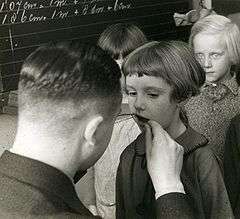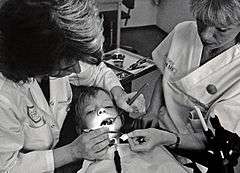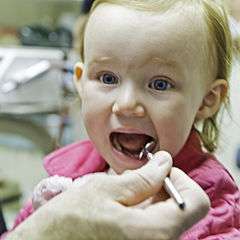Pediatric dentistry


Pediatric dentistry (formerly pedodontics in American English or paedodontics in Commonwealth English) is the branch of dentistry dealing with children from birth through adolescence.[1] The specialty of pediatric dentistry is recognized by the American Dental Association,[2] Royal College of Dentists of Canada,[3] and Royal Australasian College of Dental Surgeons.[4]

Pediatric (also paediatric or pædiatric) dentists promote the dental health of children as well as serve as educational resources for parents. It is recommended by the American Academy of Pediatric Dentistry (AAPD) and the American Academy of Pediatrics (AAP) that a dental visit should occur within six months after the presence of the first tooth or by a child's first birthday. The AAPD has said that it is important to establish a comprehensive and accessible ongoing relationship between the dentist and patient – referring to this as the patient's "dental home".[5] This is because early oral examination aids in the detection of the early stages of tooth decay. Early detection is essential to maintain oral health, modify aberrant habits, and treat as needed and as simply as possible. Additionally, parents are given a program of preventative home care (brushing/flossing/fluorides), a caries risk assessment, information on finger, thumb, and pacifier habits, advice on preventing injuries to the mouth and teeth of children, diet counseling , and information on growth and development.
Education
The first step would be to receive a bachelor's degree that focuses on biological sciences and even some child development, psychology, or even a business studies if they are wanting to open their own practice. While receiving a bachelor's degree it may be smart to intern or even volunteer for research for children that have illnesses to get first-hand experience working with children.
Second step would be to graduate from dental school. Depending on which school one goes to you would graduate with doctor of Dental Surgery (DDS) or with Doctor of Medicine in Dentistry or Doctor of Dental Medicine (DMD). Both degrees are the same and require the same courses, it just depends on what that specific school labels it. In the first two years of dental school students will be learning dental sciences and procedures in a laboratory setting. Third and fourth year of dental school will be procedures of how to diagnose and treat adult patients under the supervision of a licensed dentist. After completely this they will be a DDS or DMD. They will also be exploring clinical exercises in groups as part of the learning process. In order to become a "specialist" in pediatrics, additional education is required.[6] This may include a 24-month postgraduate residency program, which may result in a certificate or master's degree in pediatric dentistry, generally including courses in child development and child psychology. Specialized training might cover anesthesia, child oral trauma, orthodontics, oral medicine and infant oral health and child sedation. A large part of pediatric dentistry residence is spent in clinical environments observing and performing work on young real life patients.[7]
The third step would be to take The National Board Dental Examination that is administered thought the ADA and must be completed and passed for the dental graduate to become a licensed dentist. The first part of the exam is a written test on knowledge of oral health, which has to be passed in order to move on to the second half, which is the clinical exam. Followed by dental residency for two years. Once completed one receives board certification, thus becoming a Diplomate of Pediatric Dentistry.[6]
Job Description
A dentist oversees the clinical team to ensure safe and effective oral care is being provided. As a dentist, it is their responsibility to oversee that each and every procedure is being completed correctly to prevent potential risks including, but not limited to, infection, nerve damage, prolonged bleeding, hematomas and pain. Responsibilities of a dentist include:
- Diagnosing oral diseases.
- Promoting oral health.
- Creating treatment plans to maintain or restore the oral health of their patients.
- Interpreting x-rays and diagnostic tests.
- Ensuring the safe administration of anesthetics.
- Monitoring growth and development of the teeth and jaws.
- Performing surgical procedures on the teeth, bone and soft tissues of the oral cavity.
- Repairing or filing of decaying teeth.
- Fixing dental injuries, including fractured, displaced, and knocked out teeth." [8]
One of their main concerns is tooth decay prevention. Not only do they work with the teeth, pediatric dentists also look at the gums, throat muscles and nervous system of the head, neck and jaw, the tongue, and salivary glands. They do this to check for lumps, swellings, ulcers, discolorations, and other anomalies.[8] Another duty of theirs is to test for oral cancer and perform biopsies, if needed.[8]
Career Outlook
It has been reported by the U.S. Bureau of Labor Statistics job growth for pediatrics dentist will increase about 20% from 2014-2024, due to the increase in dental care from the baby boom population. The mean salary for a pediatric dentist is about $200,000 a year. Most pediatric dentist owns their own private practices or they work in comprehension. There is also an option for them to work at dental schools to teach and supervise clinical training.[7] Being a pediatric dentist there is one important factor for your everyday job, that is communication. Communication gives the dentist and the parents a good connection, where the parents can have confidence in the doctor working on their kids and also be able to follow the dentist instructions either for at home care or for pre-op and post-op instructions. Being a pediatric dentist it is important to not only have a trust within the kids but also a trust within their parents, this is always going to be established through good communication.[9] Children are miniature adults, but they are not able to always be patient and cooperative during a dental exam, cleanings or even some procedures. As a pediatric dentist they know how to examine and treat children in a way that makes them comfortable. From the way the office is decorated to the toys that are given out at the end of the visit it is all to make the children feel comfortable and to have trust in their dentist, to make the whole experience more enjoyable.[1]
See also
References
- 1 2 "What is a Pediatric Dentist?". HealthyChildren.org. 2013-11-05. Retrieved 2014-08-01.
- ↑ "Specialty Definitions". Ada.org. Retrieved 2014-08-01.
- ↑ "RCDC – Specialties". Rcdc.ca. Retrieved 2014-08-01.
- ↑ Paediatric dentistry (requires log-in)
- ↑ "Definition Of A Dental Home" (PDF). AAPD. June 3, 2013. Retrieved 2013-06-03.
- 1 2 "How to Become a Pediatric Dentist". Doctorly.org. Retrieved 2017-03-27.
- 1 2 "Pediatric Dentistry Careers: Job Options and Education Requirements". Study.com. Retrieved 2017-03-29.
- 1 2 3 "Dentists: Doctors of Oral Health". www.ada.org. Retrieved 2017-04-03.
- ↑ "Life of a Dentist | Pediatric Dentistry". www.asdanet.org. Retrieved 2017-03-27.
External links
Organizations